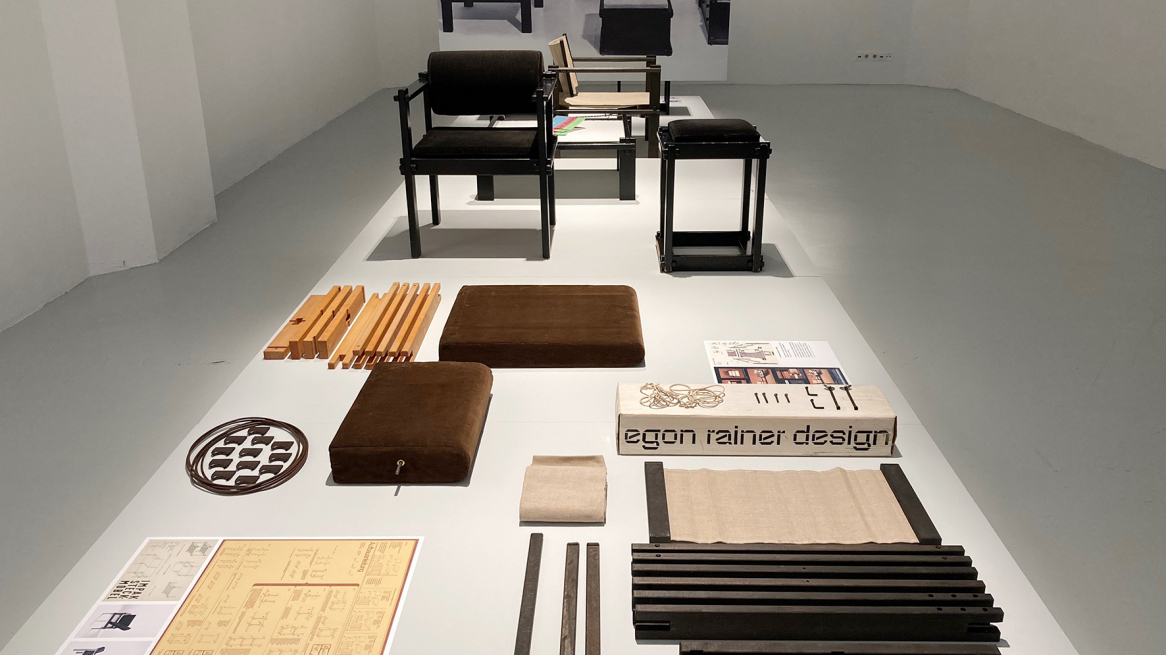
In the course of research for the exhibition "Resistance and Change. On the 1970s in Tyrol", aut staff member Claudia Wedekind came across the designer and interior architect Egon Rainer (1938-2019). Among other things, he had developed a plug-in furniture system in the 1960s. Her curiosity was aroused.
The exhibition "Egon Rainer - Ordnung und Lebendigkeit" runs until 19 June at aut. architektur und tirol.
ROBUSTNESS AND ELEGANCE
The system enabled laypeople to assemble chairs and other pieces of furniture themselves in just a few simple steps. At a time when the now globally represented Swedish furniture group was still unknown in this country.
In addition, Rainer's furniture stood out for its timeless elegance and robustness. It also survived frequent assembly and disassembly without any losses. Which is hard to say for the Swedish. I've had my own experiences...
When it also came to light that Rainer had designed the legendary Ski Kneissl Super Star, it was clear that the aut would like to dedicate an exhibition to him.
INTERIOR ARCHITECT AND DESIGNER
Right at the beginning of "Egon Rainer - Ordnung und Lebendigkeit" the stations of Rainer's life are listed. Born in Innsbruck in 1938, the designer and artist completed a carpentry apprenticeship. He trained as an interior designer at the Werkschule Hildesheim in Germany and attended the Staatliche Hochschule für bildende Künste in Hamburg (interior design class). In 1974 he graduated from the Royal College of Arts in London with a Master's degree.
By this time Rainer had long since received prizes and international recognition for his design furniture, which he created in his studio in Egger-Lienz-Strasse in Innsbruck . From 1966 Rainer also taught at the HTL Innsbruck in the department of arts and crafts, furniture making and interior design. A profession that he increasingly felt to be his vocation. In the following decades until his retirement, Rainer poured all his energy into the education of young people.
CREATIVE HIGH PHASE
"Why he no longer appeared as a designer from the mid-1970s onwards is a question that, despite intensive research, we are ultimately unable to answer satisfactorily," says Arno Ritter, director of the aut. The fact is that Rainer experienced his heyday as a designer and interior architect between the mid-1960s and the early 1970s. It was during this period that he created the works on display at the aut. They show him as an extremely creative and consistent interior designer.
On the one hand, there is the plug-in furniture mentioned at the beginning, which is disassembled into its individual parts and fits into compact cardboard boxes. And when assembled, they invite you to sit down immediately. In 1969 Rainer was awarded the Austrian State Prize for Good Form for this design. The furniture was produced by the Kufstein company Pirmoser.
I would immediately take some of the modular add-on furniture home with me. Excerpts from old catalogues and brochures show the range of elements and the possibilities for combining them. The stackable cantilever chairs (designed in 1966), which were unfortunately never produced, seem so modern and casual, as if they were developed yesterday.
INTERNATIONAL PERCEPTION
Rainer took part in international trade fairs such as Cologne and Munich with his works. He had them photographed by Milanese photographer Giorgio Casali, one of the most important architecture and design photographers of the time.
Rainer's objects illustrated relevant trade magazines such as the Italian architecture and design magazine domus. A photo reportage of his studio in Egger-Lienz-Strasse, which was perfectly adapted to his needs, can be found in the British design yearbook "decorative art in modern interiors" in 1973.
ORDER AND LIVELINESS
Although the studio no longer exists, the exhibition organizers were given the opportunity to visit and photograph the apartment of the former Tyrolean regional councillor for culture, Fritz Prior. Rainer had furnished it completely, and most of the interior has been preserved.
The pictures show: Rainer also focused on clear lines, timeless elegance and user-friendly spatial solutions in the field of interior design.
Guiding principles of the designer and interior architect accompany visitors through the exhibition.
"I no longer believe in furniture in the conventional sense, in the rigid, dominating, unchanging construction, but much more in movable, variable elements of the most varied structure freely placed in the room," is just one of Rainer's guiding principles, which can be read in the exhibition.
His uncompromising approach to design can be seen and experienced in the exhibition. Egon Rainer's furniture and furnishings prove to be a real discovery! It would be really cool if his furniture were produced again.
Egon Rainer - Order and Vitality
Exhibition at aut. architektur und tirol
Until 19 June 2021
aut. architektur und tirol
Lois-Welzenbacher-Platz 1
6020 Innsbruck
Tel. +43 512 571567
Mail: info@aut.cc
www.aut.cc
A catalogue has been published to accompany the exhibition with contributions by the journalist Ivona Jelčić and the artist Ernst J. Fuchs, who was a student of Egon Rainer at the HTL.
Information about the currently valid security measures regarding the Corona pandemic, opening hours and exhibition duration can be found at www.aut.cc
The event calendar of Innsbruck Tourism provides an overview of all events in Innsbruck and the surrounding area.
Photos, unless otherwise stated: © Susanne Gurschler
Rate this article
Show me the location on the map
Innsbruck has captured her heart, and the view of the Nordkette mountains soothes her soul. A journalist, non-fiction author, bookworm, amateur photographer, dog owner and mountain walker #ghostsofinnsbruck
Similar articles
"If the bee disappears from the earth, humans will only have four years to live. No more…
The first time I met Isobel Cope, I was halfway through presenting my radio show Sensations in…
Click. A privacy policy like this is accepted in no time at all. Click. And the computer…
Peruvian-born Sandra Chamochumbi Castro is a member of the Limonada Dance Company, newly founded…











